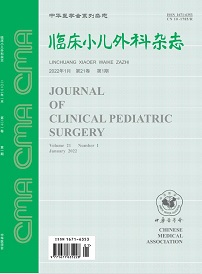Xiu Wenli,Zhao Caihong,Liu Jie,et al.Role of computer assisted surgery system in evaluating clinical outcomes of hepatic hemangioma in children[J].Journal of Clinical Pediatric Surgery,,():53-57.[doi:10.3760/cma.j.cn101785-202105003-010]
Role of computer assisted surgery system in evaluating clinical outcomes of hepatic hemangioma in children
- Keywords:
- Hepatic Hemangioma; Propranolol; Surgical Procedures; Operative; Child
- Abstract:
- Objective To explore the clinical value of Hisense CAS in evaluating the efficacy of propranolol for hepatic hemangioma in children. Methods A retrospective analysis was conducted for the relevant clinical data of 21 children treated with oral propranolol Affiliated Hospital of Qingdao University from January 2010 to December 2020.Hisense CAS was utilized for reconstructing the data of computed tomography (CT) and examining the three-dimensional relationship between tumor and blood vessels,liver and tumor volume. Results There were 12 males and 9 females.Focal type in 16 cases,multitype in 4 cases,diffuse type in 1 case; There were 9 cases of right lobe of liver,9 cases of left lobe of liver,and 3 cases of bilateral lobe involved.Tumor size significantly shrank after a treatment of propranolol.Three-dimensional reconstruction results indicated that tumor volume was 56.8(26.0168.4) cm3 pre-treatment and it declined to 10.9(8.3,22.2) cm3 post-treatment.The percentage of tumor to total liver volume pre-treatment was 23.1%(10.7%,53.6%).It dropped to 3.7%(2.7%,8.1%) post-treatment and the differences were statistically significant (P<0.05).After a treatment of propranolol,percentage of tumor volume reduction was 70.0%(47.6%,89.0%) and percentage of liver volume expansion was 8.3%(2.5%,14.4%). Conclusions Hisense CAS three-dimensional reconstruction offers advantages in evaluating volume of hepatic hemangiomas in children.Reconstructed liver volume and percentage of tumor to liver volume provide a new perspective for evaluating tumor outcomes.
References:
[1] Iacobas I, Phung TL, Adams DM, et al.Guidance document for hepatic hemangioma (infantile and congenital) evaluation and monitoring[J]. J Pediatr, 2018, 203:294-300.e2.DOI:10.1016/j.jpeds.2018.08.012.
[2] Gnarra M, Behr G, Kitajewski A, et al.History of the infantile hepatic hemangioma:from imaging to generating a differential diagnosis[J]. World J Clin Pediatr, 2016, 5(3):273-280.DOI:10.5409/wjcp.v5.i3.273.
[3] 詹江华, 王焕民.小儿肝血管瘤诊疗中存在的问题与挑战[J]. 中华小儿外科杂志, 2020, 41(11):961-962.DOI:10.3760/cma.j.cn421158-20200227-00121. Zhan JH, Wang HM.Problems and challenges in diagnosing and treating hepatic hemangioma in children[J]. Chin J Pediatr Surg, 2020, 41(11):961-962.DOI:10.3760/cma.j.cn421158-20200227-00121.
[4] 中华医学会小儿外科学分会肝胆外科学组, 中华医学会小儿外科学分会肿瘤学组.小儿肝血管瘤诊断和治疗专家共识[J]. 中华小儿外科杂志, 2020, 41(11):963-970.DOI:10.3760/cma.j.cn421158-20200228-00124. Section of Hepatobiliary Surgery, Branch of Pediatric Surgery, Chinese Medical Association, Section of Oncology, Branch of Pediatric Surgery, Chinese Medical Association.Expert consensus on diagnosing and treating hepatic hemangioma in children[J]. Chin J Pediatr Surg, 2020, 41(11):963-970.DOI:10.3760/cma.j.cn421158-20200228-00124.
[5] Varrasso G, Schiavetti A, Lanciotti S, et al.Propranolol as first-line treatment for life-threatening diffuse infantile hepatic hemangioma:a case report[J]. Hepatology, 2017, 66(1):283-285.DOI:10.1002/hep.29028.
[6] Feng ST, Chan T, Ching ASC, et al.CT and MR imaging characteristics of infantile hepatic hemangioendothelioma[J]. Eur J Radiol, 2010, 76(2):e24-e29.DOI:10.1016/j.ejrad.2010.05.027.
[7] Zavras N, Dimopoulou A, Machairas N, et al.Infantile hepatic hemangioma:current state of the art, controversies, and perspectives[J]. Eur J Pediatr, 2020, 179(1):1-8.DOI:10.1007/s00431-019-03504-7.
[8] Verma A, Jain R, Babbar N, et al.Multiple infantile hepatic hemangiomas leading to consumptive hypothyroidism successfully treated with propranolol:a case report[J]. J Family Med Prim Care, 2020, 9(11):5759-5762.DOI:10.4103/jfmpc.jfmpc_1074_20.
[9] Zhang XT, Ren WD, Song G, et al.Infantile hepatic hemangiomas associated with high-output cardiac failure and pulmonary hypertension[J]. BMC Cardiovasc Disord, 2019, 19(1):216.DOI:10.1186/s12872-019-1200-6.
[10] Long X, Wang YW, Zheng K, et al.Infantile hepatic haemangioendothelioma resection in a newborn:a case report and literature review[J]. J Int Med Res, 2020, 48(7):300060520934325.DOI:10.1177/0300060520934325.
[11] Pan FS, Xu M, Wang W, et al.Infantile hepatic hemangioendothelioma in comparison with hepatoblastoma in children:clinical and ultrasound features[J]. Hepat Mon, 2013, 13(8):e11103.DOI:10.5812/hepatmon.11103.
[12] Xu M, Pan FS, Wang W, et al.The value of clinical and ultrasound features for the diagnosis of infantile hepatic hemangioma:comparison with contrast-enhanced CT/MRI[J]. Clin Imaging, 2018, 51:311-317.DOI:10.1016/j.clinimag.2018.06.017.
[13] 段于河, 董蒨.CT三维重建及模拟手术系统在小儿肝脏外科中的应用[J]. 中华小儿外科杂志, 2015, 36(4):317-320.DOI:10.3760/cma.j.issn.0253-3006.2015.04.020. Duan YH, Dong Q.Application of CT three-dimensional reconstruction and simulation surgical system in pediatric liver surgery[J]. Chin J Pediatr Surg, 2015, 36(4):317-320.DOI:10.3760/cma.j.issn.0253-3006.2015.04.020.
[14] Tian RC, Liang Y, Wang J, et al.Propranolol for infantile hepatic hemangioendothelioma:clinical evaluation of drug efficacy and safety using a single-center patient cohort[J]. Ann Hepatol, 2020, 19(5):530-534.DOI:10.1016/j.aohep.2020.04.008.
[15] Macdonald A, Durkin N, Deganello A, et al.Historical and contemporary management of infantile hepatic hemangioma:a 30-year single-center experience[J]. Ann Surg, 2022, 275(1):e250-e255.DOI:10.1097/SLA.0000000000003881.
Memo
收稿日期:2021-5-5。
基金项目:国家自然科学基金(82293665);青岛市关键技术攻关及产业化示范类项目(24-1-4-xxgg-16-nsh)
通讯作者:董蒨,Email:18661801885@163.com
